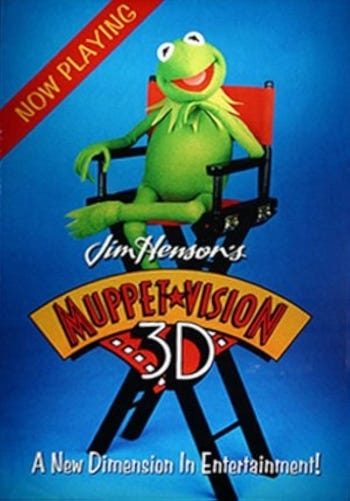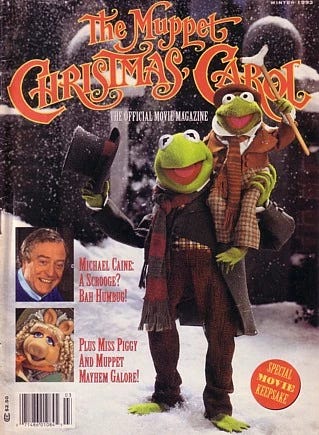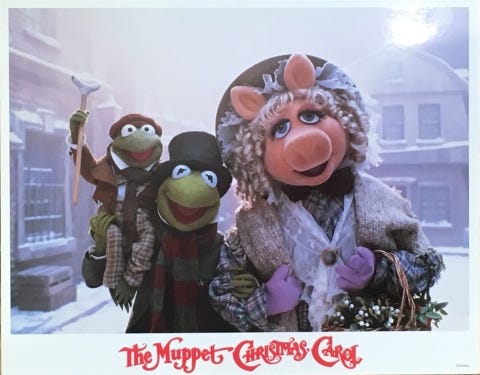If you were to look at The Muppets Collection landing page on Disney+ and didn’t know any better, you might think that Disney had been involved with Jim Henson’s legendary creations from the very beginning. The streamer offers content stretching all the way back to the 1970s, including all five seasons of The Muppet Show, the classic original The Muppet Movie and its immediate sequel, The Great Muppet Caper. But Disney did not formally begin its association with the Muppets until 1992’s The Muppet Christmas Carol, two years after Henson’s death, and didn’t fully acquire the characters until more than a decade later. In fact, the Muppets have served so many corporate masters, it’s a small miracle and a testament to Henson’s creative genius that their essence has remained more or less intact all these years later.
I don’t want to go too far into the weeds with the history of Henson’s Muppets. That story has been well-documented elsewhere and if you aren’t at least somewhat familiar with the Muppets…I mean, come on. Are you sure you’re even interested in pop culture? Suffice it to say, Michael Eisner took an interest in acquiring the Muppets early in his Disney tenure and began negotiations with Jim Henson in 1989. At the time, the Muppets hadn’t appeared on the big screen since The Muppets Take Manhattan in 1984 (I’m exempting the 1986 Sesame Street movie Follow That Bird for reasons that will become clear in a moment) although they’d continued popping up on television.
Eisner was willing to pay $150 million for the Muppets. But he wanted them all, including Big Bird, Bert, Ernie and the rest of their Sesame Street pals. Henson said absolutely not. The Sesame Street gang was its own thing, off limits, to remain safely ensconced away from corporate interests. That wasn’t what Eisner wanted to hear but eventually, he and Henson reached an Agreement in Principle. They announced the proposed merger in August of 1989 with the understanding that Henson would remain the key creative force behind the Muppets.
Henson even produced a promotional TV special, The Muppets At Walt Disney World, which aired on The Magical World Of Disney in May of 1990. In it, the gang crashes the gates at Florida’s Magic Kingdom. They split up (allowing them to show off more of the park) while security guard Charles Grodin enlists the aid of Rizzo the Rat to capture them. Their adventure culminates with Kermit and Miss Piggy appearing in the Indiana Jones Epic Stunt Spectacular!, where Grodin finally catches up to them. When Kermit belatedly reveals that he and Mickey Mouse are old friends (they’re both longtime members of FASA, Fictional Animal Stars of America), the Muppets are shown to his office, where Mickey tells them, “Welcome to the family.”
This would turn out to be the last project Henson completed in his lifetime. On May 16, just ten days after the Muppets’ theme park commercial aired, Jim Henson died of streptococcal toxic shock syndrome at the age of 53. In a later interview, his longtime creative partner Frank Oz would posit that the stress of dealing with Disney led to his illness and death. Without Henson at the helm, Eisner canceled the deal, agreeing instead to a more limited licensing arrangement for movies and use of the characters within the parks.
A year after Henson’s death, Muppet*Vision 3D opened at Disney’s Hollywood Studios in Walt Disney World. The attraction had been in development while Henson was still alive and quickly became a beloved part of the park. When Disney finally announced that it would be permanently closing in June of 2025, Muppet fans were quick to express their outrage, forcing the studio to issue a statement that they were “exploring ways to preserve the film and other parts of the experience”. Muppet*Vision 3D has, as of this writing, been the only theme park attraction to come out of the Disney/Muppet deal.
Completing work on something Jim had started was one thing. Carrying on without him was something else. Immediately after his death, Jim’s son, Brian Henson, called a meeting of the Muppet performers to gauge the temperature of the room. Everyone agreed that this was more than just a job, it was a calling. If it was at all possible for them to carry on without their beloved leader, they should give it a shot.
It was the Muppets’ agent at CAA, Bill Haber, who initially suggested the team adapt Charles Dickens’ A Christmas Carol. Brian Henson was reluctant at first. The story had been filmed so often that he wasn’t sure the Muppets could bring anything new to it. By the time he’d agreed the idea had merit, Haber had sold the concept to ABC as a TV special.
Longtime Muppet head writer Jerry Juhl set to work on the script and figured out exactly how the team could put their own stamp on the familiar story. Juhl wanted to use as much of Dickens’ actual prose as possible to make a version that was extremely faithful to its source. To make that happen, he inserted Charles Dickens himself into the film as an on-screen narrator. And the least likely Muppet to portray Dickens was the Great Gonzo. Bringing Dickens’ words into the film established the tone and atmosphere. The story took care of itself and allowed the Muppets to be Muppets.
This was a brilliant idea on a couple of levels. First, we’re already used to the Muppets as a repertory company of performers, doing vaudeville sketches and songs on The Muppet Show and traveling to Hollywood in search of the standard Rich and Famous contract in The Muppet Movie. When we see them in The Muppet Christmas Carol, we immediately accept them as the movie stars they are, playing a new part. And it doesn’t hurt that A Christmas Carol has roles tailor-made for the Muppets. Kermit is an ideal Bob Cratchit, Statler and Waldorf are perfect choices to double-down on Marley’s Ghost and if a story already has a character named Fezziwig, you’re practically asking to have Fozzie Bear play him sooner or later.
Originally, the plan was to have familiar Muppet characters like Scooter, Miss Piggy and Gonzo appear as the three spirits who visit Scrooge. But once Gonzo was recast as Dickens, Juhl and Henson reconsidered the idea. They were afraid having familiar faces in the roles would detract from the dramatic arc of the story. Instead, all-new Muppet characters were designed for the Ghosts of Christmas Past, Present and Future. This was another smart move that allowed the Muppets’ anarchic energy to exist without overwhelming the heart and soul of the story.
By now, the folks at Disney were enthusiastic enough about the project to promote it from TV special to full-length feature film. Unlike previous Muppet movies that relegated most of the human actors to supporting parts and celebrity cameos, The Muppet Christmas Carol would revolve around one leading man. A number of names were considered to play Scrooge, including Peter O’Toole, David Warner and, for some reason, George Carlin. But Henson’s first choice had always been Michael Caine. Fortunately, Caine was eager to work with the Muppets. He'd been living in America when The Muppet Show had been being shot in the UK. A lot of his friends had appeared on the show, including Roger Moore and Peter Sellers, and everyone had told him what a great time they’d had. While Henson was trying to set up a meeting with Caine, Caine found out about the project and asked his agent to set up a meeting with Henson. Caine understood the assignment perfectly. He plays the role absolutely straight and makes his costars completely real in his eyes and ours. Even without the Muppets around him, this would be one of the all-time great Scrooge performances.
Everyone knew The Muppet Christmas Carol was going to be a make-or-break project for the team. Brian Henson had never directed before. He’d followed in his father’s footsteps from an early age, becoming a first-class puppeteer with a particular gift for marionettes. In 1985, he’d performed the character Jack Pumpkinhead in Disney’s Return To Oz. But this would be his first time leading his father’s company and he tried very hard to get somebody else to do it.
Henson wasn’t the only one with big shoes to fill. This would be the biggest test yet for Steve Whitmire, the Muppet performer who had inherited the role of Kermit the Frog from Jim Henson. Whitmire was understandably nervous about taking on such an iconic character. In a later interview, Whitmire said a dream of Jim Henson reassuring him that his nerves would pass helped get him through the first day recording the songs.
Brian Henson wisely surrounded himself with Muppet veterans throughout, including songwriter Paul Williams. Williams had been responsible for some of the Muppets’ best and most memorable music, including the Oscar-nominated “Rainbow Connection” from The Muppet Movie and, my personal favorite, Emmet Otter’s Jug-Band Christmas. I will confess, the songs in The Muppet Christmas Carol didn’t immediately hook me like Williams’ previous Muppet music. But in the years since, the best of them have steadily grown on me, especially “It Feels Like Christmas” and “Thankful Heart”.
The juxtaposition of the free-wheeling Muppets against a dark, albeit ultimately uplifting, story and setting shouldn’t work as well as it does. Indeed, there were critics at the time who felt it didn’t work. But there had always been a darkness to Jim Henson’s work, most explicitly in movies like The Dark Crystal and Labyrinth. Bringing it to the foreground in a Muppet movie only demonstrates how powerful the Muppets’ inherent lightness can be.
The Muppet Christmas Carol shows that Jim Henson’s creations had, over time, become a near-perfect delivery system for a wide variety of stories and humor. Disney’s previous version of Dickens’ story, Mickey’s Christmas Carol, had attempted the same thing about a decade earlier. But as good as that short film was, the Muppets do it better. Part of that lies in the choice to keep familiar characters out of the roles of Scrooge and the three spirits. But the Muppets also had better analogues for the remaining characters. Goofy was a fun choice to play Marley but he didn’t really make much sense. Nothing about Goofy suggests that he should be doomed to an afterlife of chains, unlike Statler and Waldorf. And it was fun to see Ratty and Moley from The Adventures Of Ichabod And Mr. Toad pop up collecting for the poor, but they’re relatively obscure characters. It’s a lot more fun to see Dr. Bunsen Honeydew and Beaker in the roles.
Disney released The Muppet Christmas Carol nationwide on December 11, 1992. During its opening weekend, it played on nearly twice as many screens as Disney’s other big holiday release, Aladdin. It opened in a somewhat disappointing sixth place, earning just over $5 million and well behind hits like A Few Good Men, Home Alone 2, The Bodyguard and Aladdin. Needless to say, a movie like this wasn’t going to have much longevity in cinemas past December 25. By the end of its run, it had pulled in a little over $27 million, making it a modest hit.
Over the years, The Muppet Christmas Carol has steadily picked up admirers (unlike, say, its contemporary, Home Alone 2, which hasn’t aged nearly as well), particularly in the UK, to become a holiday perennial. Michael Caine himself has said repeatedly that it’s one of his favorite films that he’s ever made and the loveliest time he ever had on a set. The combination of Dickens’ immortal story with the timeless charms of the Muppets has proven to be irresistible.
Most importantly, the Muppet performers felt good about the finished product. They’d picked up the baton from their dearly departed leader and proven to themselves and the world that his work would live on. Longtime Muppet fans, including myself, breathed a sigh of relief, knowing the beloved characters were still in good hands. The Muppets will return.
VERDICT: Not only a Disney Plus but, more importantly, a Muppet Plus.











. Rumor has it that Caine took the role so that his children could actually watch one of his movies for a change. While the movie has tons of humor, Caine shares almost none of it. Credit due, he plays the role completely straight; selfish and cruel at the outset, then with eyes welling with tears more than once as he is shown the error of his ways over and over again.
What surprised me the most (and it probably shouldn’t have) is how these figures of felt and yarn do such an amazing job of wringing emotions out of scenes I’ve already seen multiple times in other iterations. When Kermit comes home after burying Tiny Tim, he says, “Life is a series of meetings and partings. That is the way of it,” I was devastated, not just by the line, but by the masterful delivery of it.
The true genius of art is in not only its effect on the audience, but in its universality; for us to be able to see ourselves in the mirror it holds up. The reflection isn’t always a pretty one, but hopefully it changes us for the better.